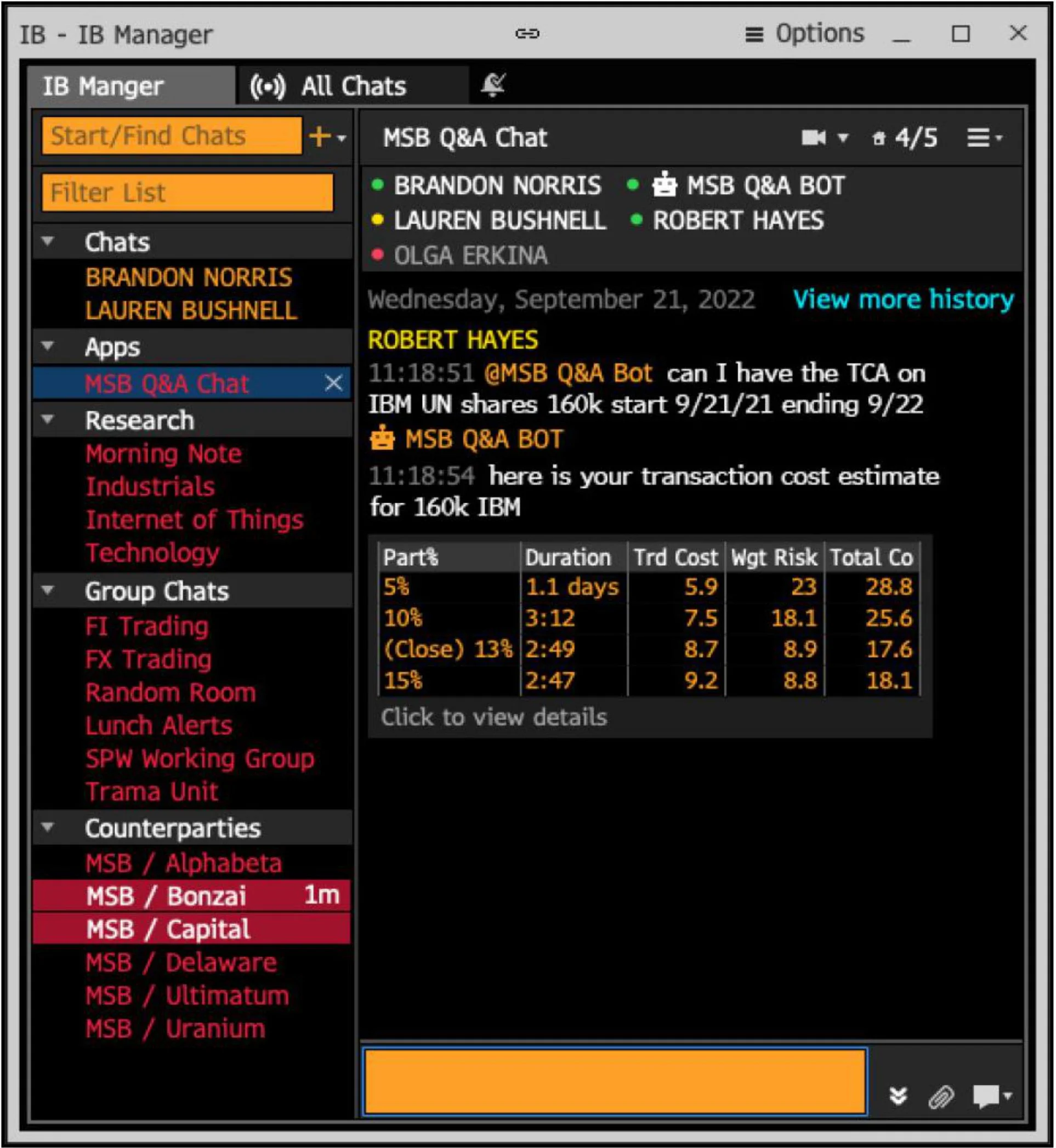Bloomberg deploys new chatbot tool to Terminal
The offering allows users to surface data and notifications from internal systems without ever having to leave Instant Bloomberg chatrooms.

Bloomberg has developed a new chatbot offering for its Instant Bloomberg chat and collaboration tool. Dubbed Intra-Firm Chatbots, the add-on service will allow users to add approved, proprietary chatbots to IB chatrooms. It is part of the IB Connect set of services that enable Bloomberg Terminal users to integrate IB with their firms’ in-house applications.
At its core, the service helps a user assign a Bloomberg identity to a piece of in-house technology and interact with that technology through IB.
“What was happening, typically, is traders were doing a lot of content switching—they have to go to [an internal application] and get information, come back, find the IB chat, and then they go back with that response,” Roger Birch, head of product for Communication and Collaboration Systems for IB at Bloomberg, tells WatersTechnology.
A trader can have a dozen or more applications open on their desktop. If they want to pull information from those systems—say, an order management system, transaction-cost analysis application, or customer-relationship management platform—they have to leave the chat and go find that information on their own. Similarly, an alert from an internal app will likely force a user to leave IB.
A firm may use an Intra-Firm Chatbot to help with one or several parts of their workflow. Each Intra-Firm Chatbot is created with a single, two-way connection, and clients may connect to their application. On IB, the agent’s last name is always “BOT” and users are encouraged to choose a first name according to their firm, desk, or workflow.
“What this does is it allows you to stay in IB, then @-mention the bot and tell it the information you want fetched. Or, the other way is you can have the system give you an alert programmatically, and it sends that one-way alert to you,” Birch says.
If you are running multiple strategies across numerous systems, having the bot go out and gather the information you need and return it to one place drives significant efficiencies
Philip Raciti, Bardin Hill Investment Partners
Bardin Hill Investment Partners, which specializes in credit and event-driven strategies and manages $5 billion of assets, is one of the early users of Intra-Firm Chatbots. Philip Raciti, head of performing credit and a portfolio manager at the New York-based firm, tells WatersTechnology that his team was “pretty excited” when they heard that Bloomberg was developing a chatbot within IB.
“We structure and utilize a large amount of data, and spend a lot of time running analysis on new datafeeds and leveraging it across our platform. Bloomberg is a bit of a silo in terms of how that information is stored and so much of our day-to-day communication and activity takes place in chatrooms,” he says. “At the end of the day, a lot of that information stays there; some of it makes it back, but it makes it back with effort.”
By using this technology, Bardin Hill traders can use its unique identifier to tag an issuer or industry and type up a note, he says. Then, in real time, chatbots will automatically “write” that note into the firm’s front-office system, sourced chronologically.
“If you are running multiple strategies across numerous systems, having the bot go out and gather the information you need and return it to one place drives significant efficiencies,” he says.
Raciti says Bardin Hill’s implementation was “pretty straightforward” and “bare bones”. For the future, though, the firm is looking to implement a large language model within its front-office system, and they need as much information as possible—having information sitting in an outside chatroom is not helpful when building these data-rich models. As such, the firm plans to expand the way it is currently using the tool.
Intra-Firm Chatbots is a subscription-based offering, but officials declined to provide details as to the specific pricing structure.
A chatbot, but not generative
To ensure privacy requirements are met and that authorized users are using data that’s in line with their licensing agreements, chatbots are built by the client according to the specs in Bloomberg’s software development kit and customized for their needs. Intra-Firm Chatbots can only pass info between IB and a client’s proprietary system.
The firm receives structured representations of IB data in JSON when the chatbot is addressed, and may send posts to IB chat rooms under the chatbot identity programmatically, using an API endpoint for delivering chatbot messages. The firm owns the logic for how to interpret the IB data it receives, and when or how the chatbot should post content.

The offering features a Q&A component that fetches data from a query with two-way communication between IB Connect and the client’s systems to answer chat queries directed to the Intra-Firm Chatbot. The tool also provides a notification system that delivers one-way alerts to, say, provide critical updates or notify a trader when specific market conditions are met. Furthermore, it can be used via a user’s desktop or on their mobile device.
Since the launch of OpenAI’s ChatGPT chatbot last year, the term “chatbot” is increasingly used interchangeably with generative AI. Earlier this year, Bloomberg launched BloombergGPT. While it shares the “GPT” moniker with OpenAI’s tool—GPT being short for generative pre-trained transformer—it is not a chatbot. Rather, BloombergGPT is being developed to help assist—and provide more depth to—the Terminal’s sentiment analysis, named-entity recognition, news classification, charting and question-answering capabilities, among other functions.
Essentially, BloombergGPT was created to help users surface content that’s already in the Terminal using a Q&A format. While also conversational, the Intra-Firm Chatbots offering is not generative. Though it does have a similar goal as BloombergGPT—surface content that’s in a firm’s own systems and making that available in the context of IB chats in the Terminal.
It uses proprietary natural language processing techniques to structure unstructured text and presents it back in the IB chat—it is not generating something new. For example, though, Bloomberg’s NLP provides additional context and enrichments referring to ‘direction,’ ‘size,’ and ‘intent’ (axe or inquiry) from the user’s own message (i.e., are they offering a security, trying to trade, and which way/how much). Intra-Firm Chatbots structures that data via tables and performs tabulations.
“We provide the framework to which the user can then map and code up their applications to this chatbot. Think of it as a developer kit: Here’s the framework. You get an identifier for the bot. The bot gets a name,” says Bloomberg’s Birch. “So, you’re at a hedge fund and you have a number of applications that you wanted to surface and bring that intel into your IB for your front-office users. We provide that framework, that developer kit, you have your applications, it’s over a Rest API, you map accordingly, it brings the content in.”
Only users who have a paid subscription or are part of a corporate subscription are able to print or copy content.
To access these options, along with all other subscription benefits, please contact info@waterstechnology.com or view our subscription options here: http://subscriptions.waterstechnology.com/subscribe
You are currently unable to print this content. Please contact info@waterstechnology.com to find out more.
You are currently unable to copy this content. Please contact info@waterstechnology.com to find out more.
Copyright Infopro Digital Limited. All rights reserved.
As outlined in our terms and conditions, https://www.infopro-digital.com/terms-and-conditions/subscriptions/ (point 2.4), printing is limited to a single copy.
If you would like to purchase additional rights please email info@waterstechnology.com
Copyright Infopro Digital Limited. All rights reserved.
You may share this content using our article tools. As outlined in our terms and conditions, https://www.infopro-digital.com/terms-and-conditions/subscriptions/ (clause 2.4), an Authorised User may only make one copy of the materials for their own personal use. You must also comply with the restrictions in clause 2.5.
If you would like to purchase additional rights please email info@waterstechnology.com
More on Trading Tech
Recent volatility highlights tech’s vital role in fixed income pricing
MarketAxess’ Julien Alexandre discusses how cutting-edge technology is transforming pricing and execution in the fixed income market amid periodic bouts of volatility
Banks fret over vendor contracts as Dora deadline looms
Thousands of vendor contracts will need repapering to comply with EU’s new digital resilience rules
Where have all the exchange platform providers gone?
The IMD Wrap: Running an exchange is a profitable business. The margins on market data sales alone can be staggering. And since every exchange needs a reliable and efficient exchange technology stack, Max asks why more vendors aren’t diving into this space.
This Week: Trading Technologies completes ANS deal; State Street; Equinix; and more
A summary of the latest financial technology news.
Interactive Brokers looks beyond US borders for growth opportunities
As retail trading has grown in volume and importance, Interactive Brokers and others are expanding international offerings and marketing abroad.
JP Morgan’s goal of STP in loans materializes on Versana’s platform
The accomplishment highlights the budding digitization of private credit, though it’s still a long road ahead.
As data volumes explode, expect more outages
Waters Wrap: At least for those unprepared—though preparation is no easy task—says Anthony.
This Week: ICE Bonds and MarketAxess plan to connect liquidity networks, TS Imagine, Bloomberg, and more
A summary of the latest financial technology news.








